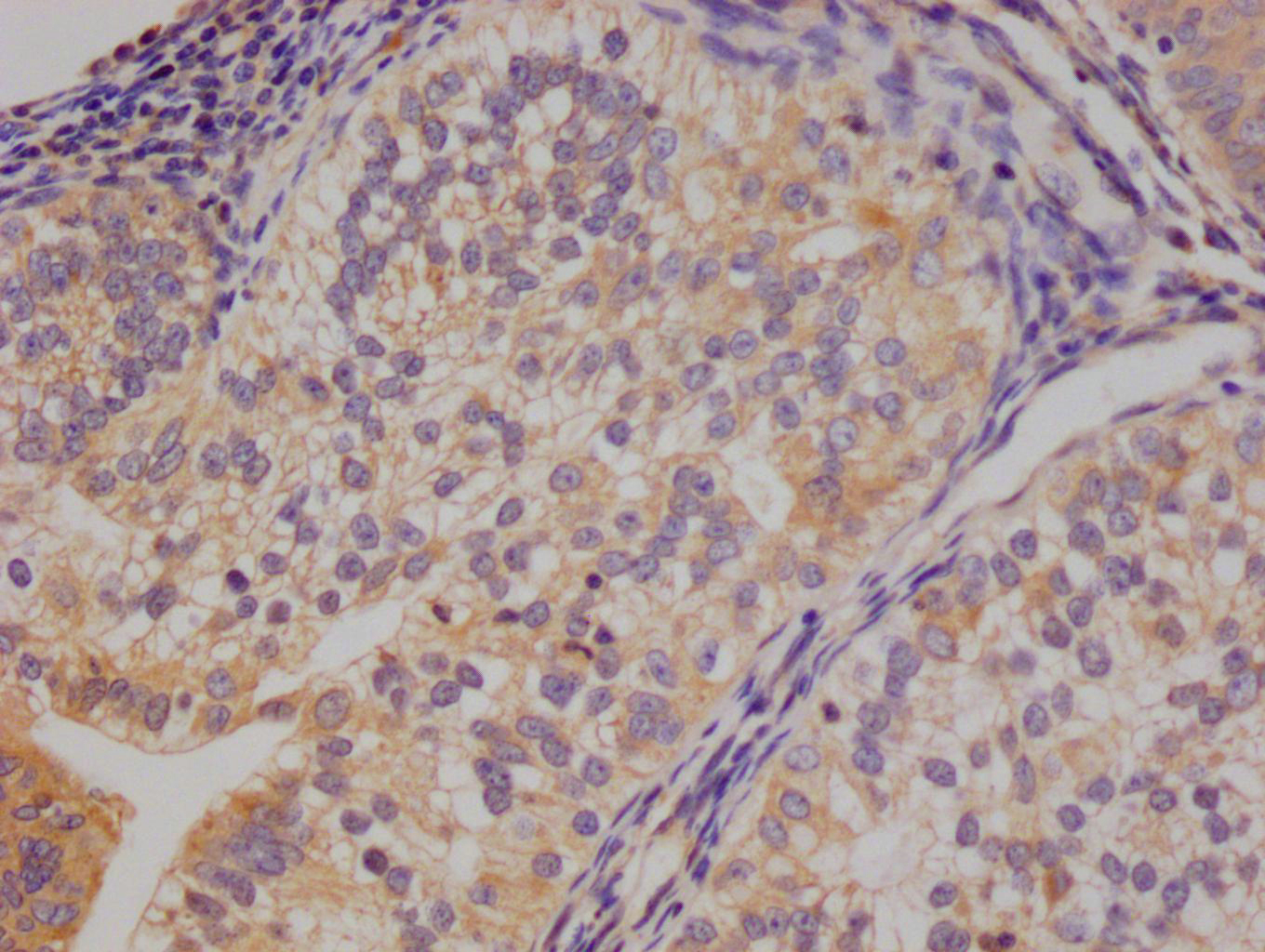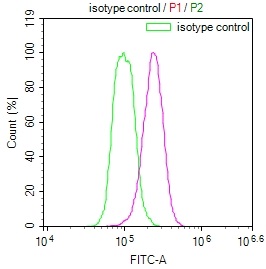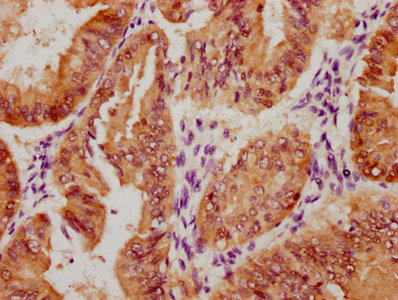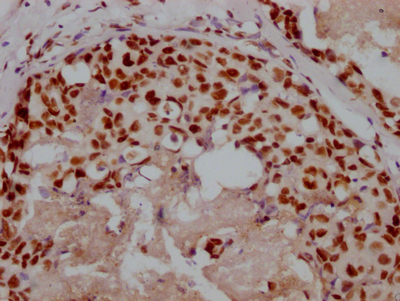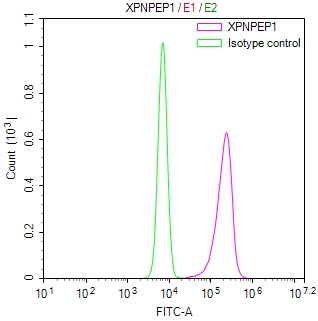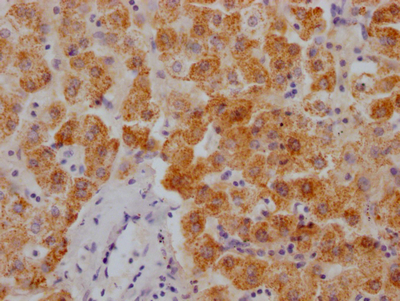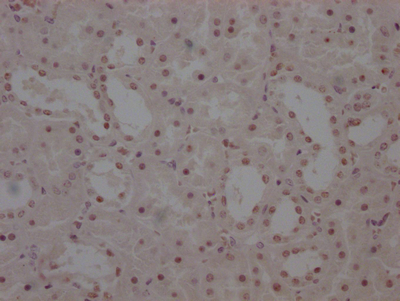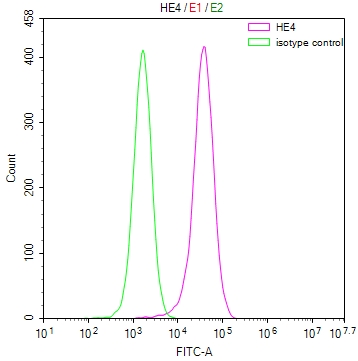PTGER4 Antibody
-
中文名稱:PTGER4兔多克隆抗體
-
貨號:CSB-PA949253
-
規格:¥1100
-
圖片:
-
其他:
產品詳情
-
Uniprot No.:
-
基因名:
-
別名:PTGER4; PTGER2; Prostaglandin E2 receptor EP4 subtype; PGE receptor EP4 subtype; PGE2 receptor EP4 subtype; Prostanoid EP4 receptor
-
宿主:Rabbit
-
反應種屬:Human
-
免疫原:Synthetic peptide of Human PTGER4
-
免疫原種屬:Homo sapiens (Human)
-
標記方式:Non-conjugated
-
抗體亞型:IgG
-
純化方式:Antigen affinity purification
-
濃度:It differs from different batches. Please contact us to confirm it.
-
保存緩沖液:-20°C, pH7.4 PBS, 0.05% NaN3, 40% Glycerol
-
產品提供形式:Liquid
-
應用范圍:ELISA,WB
-
推薦稀釋比:
Application Recommended Dilution ELISA 1:2000-1:5000 WB 1:500-1:2000 -
Protocols:
-
儲存條件:Upon receipt, store at -20°C or -80°C. Avoid repeated freeze.
-
貨期:Basically, we can dispatch the products out in 1-3 working days after receiving your orders. Delivery time maybe differs from different purchasing way or location, please kindly consult your local distributors for specific delivery time.
-
用途:For Research Use Only. Not for use in diagnostic or therapeutic procedures.
相關產品
靶點詳情
-
功能:Receptor for prostaglandin E2 (PGE2). The activity of this receptor is mediated by G(s) proteins that stimulate adenylate cyclase. Has a relaxing effect on smooth muscle. May play an important role in regulating renal hemodynamics, intestinal epithelial transport, adrenal aldosterone secretion, and uterine function.
-
基因功能參考文獻:
- Case Report: elevated EP4 expression in pulmonary hypertension patient with dissecting pulmonary aneurysm. PMID: 28108433
- Collectively, these results indicate that COX-1/PGE2/EP4 upregulates the beta-arr1 mediated Akt signaling pathway to provide mucosal protection in colitis. PMID: 28432343
- Reprogramming of mammary epithelial cells can result from EP4 -mediated stem cell property transfer by extracellular vesicles/exosomes containing caveolae-associated proteins, between mammary basal and luminal epithelial cells. PMID: 27506158
- High PTGER4 methylation is associated with Lung cancer. PMID: 27544059
- These results indicate that the blockage of PGE2-EP4 signaling prevents the bone destruction required for prostate cancer metastases, and that this is, in part due to the abrogation of bone cell responses. The study provides further evidence that an EP4 antagonist is a candidate for the treatment of prostate cancer in the blockade of bone metastasis. PMID: 27450806
- The results show that stimulation with the selective EP4 agonist CAY10598 or PGE2 promotes invadopodia-mediated degradation of the ECM, as well as the invasion of breast cancer cells in in vitro models. PMID: 28094049
- EP4 expression can promote the development of resistance to aromatase inhibitor therapy for breast cancer PMID: 27869171
- Findings suggest SUMO-1 protein and PGE2 receptor subtype 4 (EP4) as two potential targets for new therapeutic or prevention strategies for endometrial cancers. PMID: 27230680
- GW627368X therefore effectively inhibits cervical cancer survival, motility, proliferation and angiogenesis by blocking EP4/EGFR interactive signaling. PMID: 27010855
- The cross-talk between SP1 and p65, and the positive feedback regulatory loop of PI3-K/Akt signaling by EP4 contribute to the overall responses of solamargine in this process PMID: 26689593
- The PTGER4 gene is a candidate risk factor for radiological progression in rheumatoid arthritis PMID: 26538147
- IP and EP4 receptors have a role in prostanoid regulation of angiogeneis PMID: 26188701
- miRNA 526b is a COX-2 upregulated, oncogenic miRNA promoting stem-like cells, the expression of which follows EP4 receptor-mediated signaling. PMID: 25733698
- Altered inhibitory function of the EP4R in eosinophils and monocytes from aspirin-intolerant patients PMID: 25531811
- TGF-beta2 therefore promotes the adhesion and invasiveness of virulent macrophages by modulating COX2, EP4, and PKIG transcription to initiate a prostaglandin E2 (PGE2)-driven autostimulatory loop that augments PKA and EPAC activities. PMID: 25690101
- PGE2 upregulates c-myc in hepatocellular carcinoma via PTGER4 signaling. PMID: 25109834
- Gene expression analysis revealed that three gene BACH2, PTGER4 and ZFP36L1, are down-regulated in MS patients' blood cells compared to healthy subjects. PMID: 25670004
- The PTGER4 modulating variant rs7720838 increases susceptibility for Crohn's disease and might resemble a risk factor for stricturing disease behavior. PMID: 24793213
- the microsomal PGE2-synthase-1/PGE-receptor-4 axis is increased by smoking in human abdominal aortic aneurysms PMID: 24876670
- potential relevance of the COX-2/mPGES-1/EP-4 axis in the AAA-associated hypervascularization PMID: 24133193
- JARID1A, JMY, and PTGER4 polymorphisms are related to ankylosing spondylitis in Chinese Han patients. PMID: 24069348
- Four single nucleotide polymorphisms in two genes in the PGE2 family, PTGES2 and PTGER4, were significantly associated with primary graft dysfunction after lung transplantation. PMID: 24467603
- PGE2 production induced by pathogen recognition receptors/p38 MAPK signaling is up-regulated by EP4-triggered signaling to maintain an effective PGE2 concentration. PMID: 23759445
- This is the first report to demonstrate that Lymphocytic colitis is associated with increased TNF-alpha, INF-gamma and IL-8 concurrent with a marked up-regulation of EP4. PMID: 23613969
- PGE2 induces MUC2 and MUC5AC expression in intrahepatic biliary epithelial cells via EP4-p38MAPK signaling. PMID: 23619266
- Data indicate that PGE2 regulates pancreatic stellate cell profibrotic activities via EP4 receptor, thus suggesting EP4 receptor as useful therapeutic target for pancreatic cancer to reduce desmoplasia. PMID: 23090667
- Activation of E-type prostanoid (EP) 4 receptor by PGE(2) or an EP4-selective agonist (ONO AE1-329) enhanced the barrier function of human microvascular lung endothelial cells. PMID: 22704539
- Single nucleotide polymorphisms in the PTGER4 gene regulatory sequences are strongly associated with Crohn's disease susceptibility. PMID: 23300802
- The PTGER4 -1254 G allele demonstrated a higher frequency in aspirin-intolerant chronic urticaria (AICU)patients and lower promoter activity with decreased expression of PTGER4 and contributes to the development of AICU. PMID: 22695889
- different EP receptors (EP(1-4)) to PGE(2)-induced anion secretion in human and mouse colon mucosa PMID: 22732652
- With HO as a model oxidant stress, stimulation of CFTR seems to involve PGE production and likely EP receptor activation in Calu-3 airway epithelial cells. PMID: 22362924
- EP-4 receptor expression is modulated at the post-transcriptional level by miR-101. PMID: 22353936
- Prostaglandin E2 produced by Entamoeba histolytica signals via EP4 receptor and alters claudin-4 to increase ion permeability of tight junctions PMID: 21683675
- PGE(2) enhances IL-8 production via EP4 receptor coupled to G(s) protein in human pulmonary microvascular endothelial cells PMID: 22080750
- Prostaglandin EP4 receptor enhances BCR-induced apoptosis of immature B cells PMID: 21600299
- EP4 receptors are expressed by human eosinophils, and are also present on infiltrating leukocytes in inflamed human nasal mucosa. PMID: 21365278
- Human kidney cells evidence increased EP4 and decreased Rap1GAP expression levels in the malignant compared with benign samples. PMID: 21832044
- Data suggest that PGE(2) -EP4 signaling might be protective against allergic responses by inhibiting the interaction of eosinophils with the endothelium and might hence be a useful therapeutic option for controlling inappropriate eosinophil infiltration. PMID: 21681739
- findings indicate early divergence in the signaling pathways stimulated by strain and establish PGE2/EP4 as the pathway used by strain to regulate Sost expression. PMID: 21723865
- found that PGE(2) and hypoxia independently induce expression of PTGER4 indicating two independent pathways regulating prostanoid receptor expression PMID: 21589857
- chronic activation of the EP receptor is associated with increased production of mediators likely to increase the pro-inflammatory milieu of airway epithelial cells. PMID: 20970516
- Results are suggestive of platelet EP4 receptor activation as a novel antithrombotic strategy. PMID: 21071691
- Data seem to rule out a major influence of these polymorphisms on UC or RA predisposition. PMID: 20561984
- Increased expression of PGE2 in the lung tumor microenvironment may initiate a mitogenic signaling cascade composed of EP4, betaArrestin1, and c-Src which mediates cancer cell migration. PMID: 20353998
- regulate activities exhibited by IBC cells that have been associated with the aggressive phenotype. ep4 regulate invasion PMID: 20503412
- EP4 overexpression, via AR activation, supports an important mechanism for castration-resistant progression of prostate cancer. PMID: 20145136
- Observational study and genome-wide association study of gene-disease association, gene-environment interaction, and pharmacogenomic / toxicogenomic. (HuGE Navigator) PMID: 20014019
- The EP4 agonist PF-04475270 is a novel ocular hypotensive compound which is bioavailable following topical dosing and effectively lowers intraocular pressure. PMID: 19445930
- Involvement of prostaglandin E receptor subtype EP(4) in colon carcinogenesis. PMID: 11782353
- Placentally derived prostaglandin E2 acts via the EP4 receptor to inhibit IL-2-dependent proliferation of CTLL-2 T cells. PMID: 11876748
顯示更多
收起更多
-
亞細胞定位:Cell membrane; Multi-pass membrane protein.
-
蛋白家族:G-protein coupled receptor 1 family
-
組織特異性:High in intestine and in peripheral blood mononuclear cells; low in lung, kidney, thymus, uterus, vasculature and brain. Not found in liver, heart, retina oe skeletal muscle.
-
數據庫鏈接:
Most popular with customers
-
-
YWHAB Recombinant Monoclonal Antibody
Applications: ELISA, WB, IHC, IF, FC
Species Reactivity: Human, Mouse, Rat
-
Phospho-YAP1 (S127) Recombinant Monoclonal Antibody
Applications: ELISA, WB, IHC
Species Reactivity: Human
-
-
-
-
-



